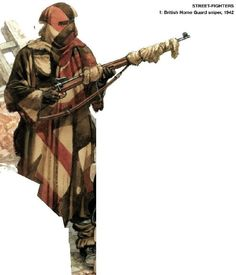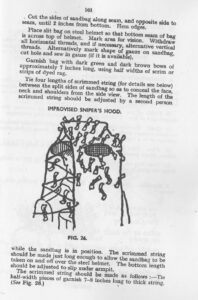Langdon-Davies is a name that has often appeared in this blog, and rightly so. His book on fieldcraft is recommended reading. This book was a best seller during the Second World War.
In a previous blog I showed his suggestion on creating a camouflage smock from hessian.
Recently I was reading a Home Guard manual published at a slightly later date and it was with some amusement I read a passage that said that due to a shortage of hessian, it was no longer available for making “sniper suits”.

The book instead suggested that equal concealment could be achieved by attaching materials and foliage to the helmet, webbing and the arms and legs of the battledress.
It also recommended a facemask made from a sandbag. Below is the relevant page. I’m aware that it is crooked. I chose to leave it this way to impress that camouflage measures should be irregular.

As per Langdon-Davies, paired eyeholes are avoided as being distinctive. The surface of the sandbag may be painted in contrasting, disruptive shapes. The skin beneath should be camouflaged with creams or other materials.
A British Infantry training manual from 1944 makes these wise observations:
(a) Fieldcraft is universal.-This is a war of infiltration into the enemy’s position-that is, war in which small parties, such as sections or even individuals, work their way through, relying on their own skill and on the power of their own weapons. Infiltration cannot be carried out unless you are an EXPERT in movement in the field, concealment, and surprise. One bad movement by one individual may ruin everything.
(b) Fieldcraft is offensive and does not mean using ground to cower in a hole out of the enemy’s fire. Ground must be used as a hunter uses it-to get closer to the prey whom he is going to kill. You must use your knowledge and cunning to outwit the enemy.
(c) Observation is paramount in offence; concealment is paramount in defence.-This is a war of concealed posts, of camouflage. You cannot kill the enemy unless you can find him. You cannot even start to attack him, if you do not know where he is.
(d) Cover from view is not cover from fire (especially if you have been seen getting there).-Train yourself to get away from enemy fire unseen. Do not dart behind a bush and stay there; that is suicide.
These comments are still relevant today, although I believe these basic principles are often neglected. Infiltration is often now regarded as a specialist skill rather than a basic requirement for the infantry role.
As a bonus, I have scanned an article on Personal Camouflage from an 1980s magazine. This is a nice, succinct summary of how to use foliage and other 3D materials to improve your camouflage.
Essentially the same advice was given in British WW2 manuals. Significantly, we seldom see such measures being taken by modern fighting men.